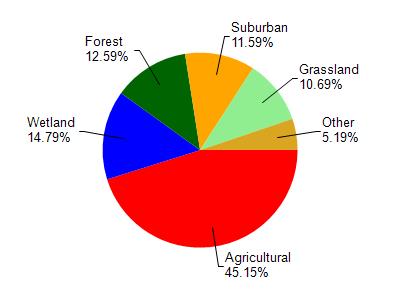Kenosha
No
No
No
Fish and Aquatic Life
Overview
Much of the shoreline of this warm water, seepage and drainage lake has been altered by dredging and filling. There are also numerous channels located on the east and south sides of the basin. For this reason much of its shoreline and contiguous lands are developed. Most of its watershed is still in agriculture but in recent years there has been an upsurge of urban development of farmland on its east side. The lake is managed for largemouth bass, northern pike, and panfish. The walleyes present are assumed to have migrated up from Camp Lake. In the past, both the DNR and local sportsmen have stocked northern pike fingerlings and adults in an effort to improve the northern pike fishery, but no known measurable increase can be attributed to these stockings. Marsh furbearers, principally muskrats, are common to the undeveloped shorelines and associated cattail marsh. Waterfowl are common, especially during spring and fall migratory flights. Public access is possible from a boat rental on the south side and a small town boat ramp with limited parking on the southwest corner.
Source: 1982, Surface Water Resources of Kenosha County Center Lake, TlN, R20E, Section 15, 16, 21, Surface Acres = 120, Maximum Depth = 28 ft, Secchi disc = 4.5 ft.
Date 1982
Author Aquatic Biologist
General Condition
Center Lake (WBIC 747300) was assessed during the 2018 listing cycle; new total phosphorus and chlorophyll-a sample data were clearly below the 2018 WisCALM listing thresholds for the Recreation use and the Fish and Aquatic Life use. This water was meeting these designated uses and was not considered impaired.
Date 2017
Author Ashley Beranek
Condition
Wisconsin has over 84,000 miles of streams, 15,000 lakes and milllions of acres of wetlands. Assessing the condition of this vast amount of water is challenging. The state's water monitoring program uses a media-based, cross-program approach to analyze water condition. An updated monitoring strategy (2015-2020) is now available. Compliance with Clean Water Act fishable, swimmable standards are located in the Executive Summary of Water Condition in 2018. See also the 'monitoring and projects' tab.
Reports
Recommendations
Nine Key Element Plan
Camp-Center Lakes PWS Plan - Nine Key Element Plan - The Camp-Center Lakes Priority Watershed Plan assesses the sources of pollution in the Camp-Center Lakes watershed and guides the implementation of nonpoint source control measures. These control measures are needed to meet specific water resource objectives for Camp Lake, Center Lake, and its tributaries in Kenosha County.
Management Goals
Wisconsin's Water Quality Standards provide qualitative and quantitative goals for waters that are protective of Fishable, Swimmable conditions [Learn more]. Waters that do not meet water quality standards are considered impaired and restoration actions are planned and carried out until the water is once again fishable and swimmable
Management goals can include creation or implementation of a Total Maximum Daily Load analysis, a Nine Key Element Plan, or other restoration work, education and outreach and more. If specific recommendations exist for this water, they will be displayed below online.
Monitoring
Monitoring the condition of a river, stream, or lake includes gathering physical, chemical, biological, and habitat data. Comprehensive studies often gather all these parameters in great detail, while lighter assessment events will involve sampling physical, chemical and biological data such as macroinvertebrates. Aquatic macroinvertebrates and fish communities integrate watershed or catchment condition, providing great insight into overall ecosystem health. Chemical and habitat parameters tell researchers more about human induced problems including contaminated runoff, point source dischargers, or habitat issues that foster or limit the potential of aquatic communities to thrive in a given area. Wisconsin's Water Monitoring Strategy was recenty updated.
Grants and Management Projects
Monitoring Projects
| WBIC | Official Waterbody Name | Station ID | Station Name | Earliest Fieldwork Date | Latest Fieldwork Date | View Station | View Data |
|---|
| 5041760 | Unnamed | 10045148 | Phragmites Occurrence - Center Lake | | | Map | Data |
| 5041760 | Unnamed | 10045149 | Phragmites Occurrence - Center Lake | | | Map | Data |
| 747300 | Center Lake | 303059 | Center Lake - Deep Hole | 7/1/1989 | 4/10/2024 | Map | Data |
| 747300 | Center Lake | 10003100 | Center Lake | 6/1/1994 | 4/10/2024 | Map | Data |
| 747300 | Center Lake | 10045148 | Phragmites Occurrence - Center Lake | | | Map | Data |
| 747300 | Center Lake | 10017506 | Center Lake -- Access at 95th St | 7/10/2012 | 7/3/2023 | Map | Data |
| 747300 | Center Lake | 10018139 | Center Lake -- Access Nr End 93rd St | | | Map | Data |
| 747300 | Center Lake | 10045149 | Phragmites Occurrence - Center Lake | | | Map | Data |
|

Watershed Characteristics
Center Lake is located in the Lower Fox River - Illinois watershed which is 114.04 mi². Land use in the watershed is primarily agricultural (45.20%), wetland (14.80%) and a mix of forest (12.60%) and other uses (27.50%). This watershed has 144.75 stream miles, 2,176.46 lake acres and 9,772.38 wetland acres.
Nonpoint Source Characteristics
This watershed is ranked Medium for runoff impacts on streams, Medium for runoff impacts on lakes and High for runoff impacts on groundwater and therefore has an overall rank of High. This value can be used in ranking the watershed or individual waterbodies for grant funding under state and county programs.This water is ranked High Lake for individual Lakes based on runoff problems and the likelihood of success from project implementation.